Comments / Questions (32)
![]() Lehmann Anne wrote:
Lehmann Anne wrote:
Liebes Team ich stricke im moment das tolle Tuch von euch nun bin ich an der neunten Reihe und komme nicht weiter kann mir bitte jemand helfen das wäre toll lg
03.02.2025 - 06:35
![]() Justyna wrote:
Justyna wrote:
Chciałam skrócić szal i po rzędzie 7 zrobić od razu 9 czy jest taka możliwość? Czytając wzór mam wrażenie, że nie zgadza mi się liczba oczek - 18 dodanych przerabiam na lewo, później na kolejnych 36 robię pierwszy z liści C ? Mam wtedy za mało o 18 oczek. Czy nie ma możliwości skrócenia szala, czy coś źle rozumiem?
25.11.2023 - 21:39DROPS Design answered:
Witaj Justyno, aby skrócić szal, po 7-mym rzędzie musisz wykonać rząd 10 i kolejne, aż do końca. Pozdrawiamy!
30.11.2023 - 08:49
![]() Martina Beck wrote:
Martina Beck wrote:
Könnten Sie ein kurzes Video zur Anleitung dieses Schals drehen? Ich verstehe die Technik nicht, wie man die Blätter einzeln strikt und dann ansetzt.
23.10.2023 - 12:33DROPS Design answered:
Liebe Frau Beck, dann kann Ihnen sicher dieses Video helfen, wir zeigen, wie die ersten Blätter gestrickt werden. Viel Spaß beim stricken!
24.10.2023 - 08:44
![]() Justyna wrote:
Justyna wrote:
Czy można dodać 1 rząd więcej po środku (między 5 a 8 rzędem), żeby szal wyszedł dłuższy ? Mam 285g włóczki (A)(ok.1000m) czy to wystarczy?
21.10.2023 - 14:59DROPS Design answered:
Witaj Justyno, można tak zrobić. Czy wystarczy włóczki, powinno, ale trudno to przewidzieć. Pozdrawiamy!
23.10.2023 - 08:40
![]() Stela wrote:
Stela wrote:
If I wanted to knitting a stole narrower for two leaves,, what would I have to do? I didn’t start yet, so I can’t wrap my mind around it.
16.01.2023 - 21:09DROPS Design answered:
Dear Stela, we are unfortunately not able to adjust every pattern to every single request, however I guess you could here just adjust the number of leaves required, for ex work row 1 and 2 as described, but from row 3 working then only 3 leaves to row 10 (only 1). Happy knititng!
17.01.2023 - 10:08
![]() María wrote:
María wrote:
Existe una errata en el patrón en Español, se necesitan agujas de 4mm pero en el montaje indica 3.5mm, entiendo que lo correcto son 4mm. ESTOLA: Montar 36 puntos con agujas circulares de 3.5 mm y Delight. Gracias.
13.01.2023 - 18:38DROPS Design answered:
Hola María, sí, se trata de una errata, son agujas de 4mm. La corregiremos lo antes posible, gracias.
15.01.2023 - 11:15
![]() Merete wrote:
Merete wrote:
Super sjov opskrift. Men jeg er nået til blad E, og jeg er usikker på måden det skal strikkes. Når jeg læser opskriften, synes jeg det virker som om, jeg skal strikke to blade direkte ovenpå hinanden (det er de to første sætninger, der forvirrer mig ). Er det korrekt læst? Det virker nemlig lidt mystisk, synes jeg , da resten af mønstret har bladene forskudt.
16.07.2020 - 06:32DROPS Design answered:
Hej Merete, jo du ser i diagram A.2 nederst at efter række 9 hvor du strikker E, fortsætter du med 10 som også er E. God fornøjelse!
30.07.2020 - 14:46
![]() Mp 54 wrote:
Mp 54 wrote:
Bonjour, mes feuilles sont bombées au milieu, alors que sur le modèle, elles paraissent plates Pouvez me dire où est mon erreur? Merci
09.03.2019 - 00:17DROPS Design answered:
Bonjour Mp54, il est possible que vous vous soyez trompée dans les rangs raccourcis de ces feuilles, quand elles sont terminées, elles doivent être toutes plates. N'hésitez pas à montrer votre ouvrage (même en photo par mail) à votre magasin, il lui sera plus facile de vous aider. Bon tricot!
11.03.2019 - 09:27
![]() Mp 54 wrote:
Mp 54 wrote:
Bonjour, mes feuilles sont bombées au milieu, alors que sur le modèle, elles paraissent plates Pouvez me dire où est mon erreur? Merci
08.03.2019 - 20:44
![]() Anette wrote:
Anette wrote:
Eine sehr schöne Anleitung, die ich schon zweimal mit der angegebenen Wolle gestrickt habe. Leider benötigte ich bei jeder Version etwas mehr als 250 g Wolle.
22.11.2018 - 11:45
Forest Fling#forestflingshawl |
||||||||||
 |
 |
|||||||||
Knitted stole with leaves in DROPS Delight. The piece is worked in garter stitch with short rows.
DROPS 196-5 |
||||||||||
|
EXPLANATIONS FOR THE PATTERN: ------------------------------------------------------- RIDGE/GARTER STITCH (worked back and forth): All rows are knitted (1 ridge = knit 2 rows). PATTERN: See diagrams A.1 and A.2. Diagram A.1 shows all the rows in the pattern seen from the right side. Diagram A.1 is read from left to right on all rows from the wrong side. All rows from the right side are read from right to left. Diagram A.2 shows the leaves as well as the knitting direction and order of rows. COLOUR SUGGESTION: To mix and change the pattern of colours while you work, you can change balls or use yarn from the other end of the ball each time you start a new row of leaves. Change colour before each START-ROW 1 and START-ROW 2 are worked. ------------------------------------------------------- START THE PIECE HERE: ------------------------------------------------------- STOLE - SHORT OVERVIEW OF THE PIECE: The piece is worked back and forth with circular needle; from the one corner, diagonally upwards in rows with different numbers of leaves. Short rows are worked over one leaf at a time. The whole piece is worked in GARTER STITCH – read description above. Markers are used, inserted between and in the middle of leaves as you work. The markers are on the needle and will follow your work upwards. They make it easier to see where the leaves are to be worked. Read also COLOUR SUGGESTION in description above. STOLE: Cast on 36 stitches with circular needle size 4 mm and Delight. Then work as follows: ROW 1: Work LEAF A as follows: LEAF A: Work diagram A.1; the first row in the diagram is from the wrong side – read description above under pattern. Work the diagram 1 time in height = 1 leaf. The first row of leaves is now finished, turn the piece. In the transition between rows 1 and 2 with leaves, work START-ROW 1 as follows: START-ROW 1: From the right side: Cast off the first 18 stitches with knit, knit 18 stitches. Turn the piece, knit 18 stitches, insert 1 marker on the needle here and cast on 18 new stitches at the end of the row from the wrong side. Turn the piece and knit to end of row from the right side, insert a marker on the needle here. Cast on 36 new stitches at the end of the row. Now you are ready to work the next row of leaves. Turn the piece. ROW 2. Work LEAVES B, C and D as follows: LEAF B: Work diagram A.1 over the first 36 stitches on the needle (as far as the first marker seen from the wrong side). Work the diagram 1 time in height (you have now worked as far as the same marker again). Turn the piece, knit 36 stitches from the right side. Turn the piece, knit 18 stitches from the wrong side, insert 1 marker on the needle here, do not turn the piece; the next leaf is worked over the next 36 stitches. LEAF C: Work diagram A.1 over the next 36 stitches on the needle (past one marker and as far as the next). Work the diagram 1 time in height. Turn the piece and knit 36 stitches from the right side. Turn the piece, knit 18 stitches from the wrong side (as far as the marker in the middle of the leaf), do not turn the piece; the next leaf is worked over the next 36 stitches. LEAF D: Work diagram A.1 over the last 36 stitches on the needle (past the last marker and to end of row). Work the diagram 1 time in height. You have now worked 3 leaves and 2 rows of leaves are finished. Work START-ROW 1 – read description above, in the transition between rows 2 and 3 of leaves. ROW 3: Work LEAF B over the first 36 stitches, work LEAF C a total of 3 times in width, work LEAF D over the last 36 stitches (= 5 leaves on the row) and work START-ROW 1 in the transition between rows 3 and 4 of leaves. ROW 4: Work LEAF B over the first 36 stitches, work LEAF C a total of 5 times in width, work LEAF D over the last 36 stitches (= 7 leaves on the row) and work START-ROW 1 in the transition between rows 4 and 5 of leaves. ROW 5: Work LEAF B over the first 36 stitches, work LEAF C a total of 7 times in width and work LEAF D over the last 36 stitches (= 9 leaves on the row). NOTE! START-ROW 1 is not worked anymore from here; you work START-ROW 2 in the transition between rows 5 and 6 of leaves as follows: START-ROW 2: From the right side: Cast off the first 36 stitches with knit, knit to end of row, insert 1 marker on the row here. Cast on 36 new stitches at the end of the row and insert 1 marker on the row here. Now you are ready for the next row of leaves which are worked from here. Turn the piece. ROW 6: Work LEAF B over the first 36 stitches, work LEAF C a total of 7 times in width, work LEAF D over the last 36 stitches (= 9 leaves) and work START-ROW 2 in the transition between rows 6 and 7 of leaves. ROW 7: Work LEAF B over the first 36 stitches, work LEAF C a total of 7 times in width, work LEAF D over the last 36 stitches (= 9 leaves) and work START-ROW 2 in the transition between rows 7 and 8 of leaves. ROW 8: Work LEAF B over the first 36 stitches, work LEAF C a total of 7 times in width, work LEAF D over the last 36 stitches (= 9 leaves) and work START-ROW 2 in the transition between rows 8 and 9 of leaves. ROW 9: Work LEAF E as follows: LEAF E: Work diagram A.1 over the first 36 stitches (as far as the first marker on the needle seen from the wrong side). Work the diagram 1 time in height (you have now worked as far as the same marker again). Turn the piece. Knit 36 stitches from the right side. Turn the piece, cast off 18 stitches from the wrong side. Turn the piece, insert 1 marker on the needle here and cast on 18 new stitches from the right side. Turn the piece, knit 18 stitches from the wrong side. Do not turn the piece as the next leaf is worked over the next 36 stitches from here. Work LEAF C a total of 7 times in width and work LEAF D over the last 36 stitches (= 9 leaves on the row). Turn the piece, cast off the first 36 stitches with knit from the right side. Knit to end of row from the right side. ROW 10: Work LEAF E over the first 36 stitches, work LEAF C a total of 5 times in width and work LEAF D over the last 36 stitches (= 7 leaves on the row). Turn the piece, cast off the first 36 stitches with knit from the right side. Knit to end of row from the right side. ROW 11: Work LEAF E over the first 36 stitches, work LEAF C a total of 3 times in width and work LEAF D over the last 36 stitches (= 5 leaves on the row). Turn the piece, cast off the first 36 stitches from the right side. Knit to end of row from the right side. ROW 12: Work LEAF E over the first 36 stitches, work LEAF C 1 time in width and work LEAF D over the last 36 stitches (= 3 leaves). Turn the piece, cast off the first 36 stitches with knit from the right side. Knit to end of row from the right side. ROW 13: Work LEAF E over the last 36 stitches, but when diagram A.1 has been worked 1 time in height, cast off all stitches from the right side. Cut and fasten the strands. |
||||||||||
Diagram explanations |
||||||||||
|
||||||||||

|
||||||||||
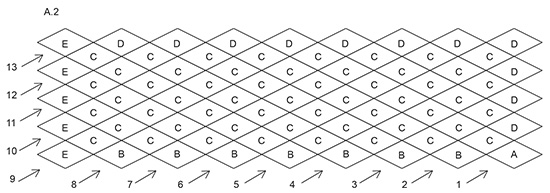
|
||||||||||
Have you finished this pattern?Tag your pictures with #dropspattern #forestflingshawl or submit them to the #dropsfan gallery. Do you need help with this pattern?You'll find 11 tutorial videos, a Comments/Questions area and more by visiting the pattern on garnstudio.com. © 1982-2025 DROPS Design A/S. We reserve all rights. This document, including all its sub-sections, has copyrights. Read more about what you can do with our patterns at the bottom of each pattern on our site. |
||||||||||







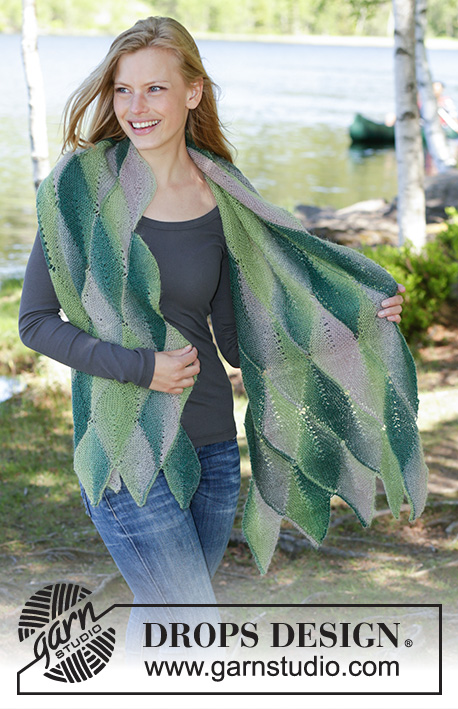
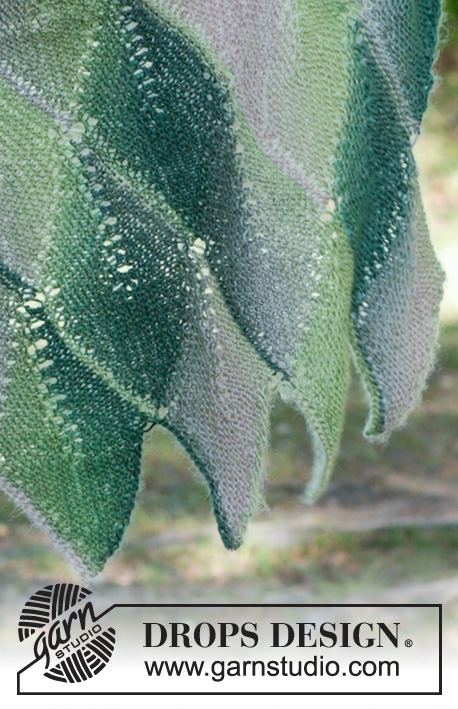


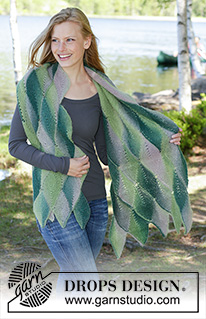
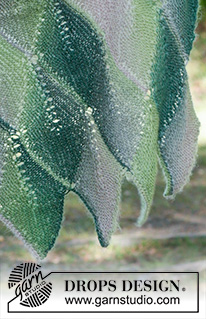




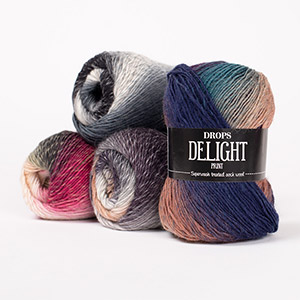






























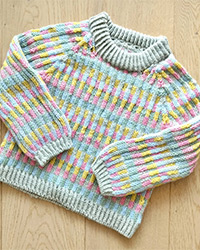
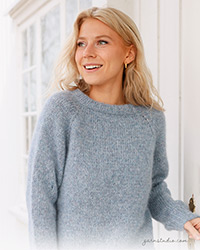


Post a comment to pattern DROPS 196-5
We would love to hear what you have to say about this pattern!
If you want to leave a question, please make sure you select the correct category in the form below, to speed up the answering process. Required fields are marked *.